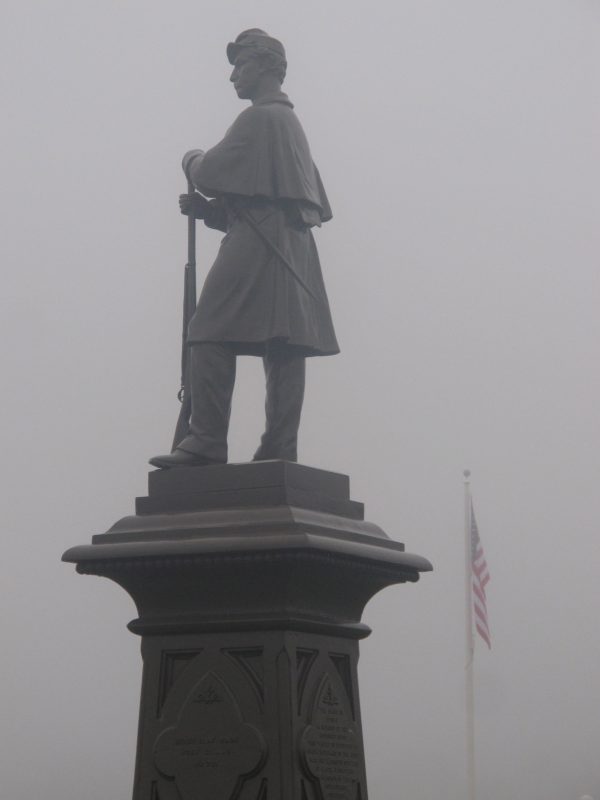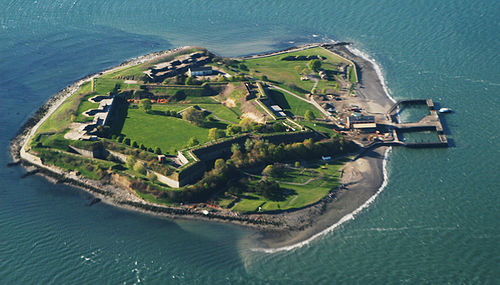Confederate Monuments in Massachusetts: Who Knew? (Part 1)
Emerging Civil War welcomes back guest author Rob Wilson
My home state of Massachusetts, like its five New England sister states, proudly displays a rich Civil War legacy. Many municipal parks and public buildings here feature a monument or memorial tablet remembering those soldiers, sailors and marines who served the Union in the struggle that ended slavery in the United States. Other statues and plaques testify to the contributions of abolitionists— both black and white— who lived and organized here: Sojourner Truth, Frederick Douglass and U.S. Senator Charles Sumner, to name a few. But there is something about the state’s list of Civil War-related monuments that makes it unique in our region: it has two public memorials honoring men who served the Confederate States of America. Both are on islands, one erected in 1963 at Georges Island State Park off Boston Harbor, and one installed in 1925 on Martha’s Vineyard, a popular vacation destination to the south of Cape Cod.
Until recently, relatively few Massachusetts residents knew the monuments existed. That changed in the aftermath of this year’s well-publicized national debate over the removals of Confederate memorials in the South. Late last spring, my state’s little-known Boston monument was suddenly the subject of frenzy of regional news reporting and editorial opinion. A contentious public conversation over its presence on state property followed, leading to the monument being boarded up for the summer. It was removed and shipped to the Massachusetts archives in late October.[i] After the August violence in Charlottesville, a much more limited monument debate flared up in the letters-to-the-editor sections of Martha’s Vineyard newspapers. In September, both the news coverage and the letters subsided.

The Bay State is more than 300 miles north of the Mason-Dixon Line and most of the headline-grabbing monument debates and removals. What, in the first place, are two memorials to Confederates doing in public spaces way up here in the Bay State? And why is one Massachusetts memorial so much more controversial than the other that it now is on the national tally of Confederate statues and memorials that have been taken down and carted away? The answers to those questions are embedded within the fascinating and very different origin stories of the two monuments, and the symbols and inscriptions on each.
Boston’s Confederate monument sat outside Fort Warren, a military outpost that was converted into a prison soon after the war began. Today the island fortress is a National Historic Landmark. The granite memorial there honors the 13 men who died of disease while imprisoned there. It was erected during the Civil War Centennial, in 1963, making it a relative newcomer to the state’s Civil War monument landscape. (Photos of Fort Warren’s monument)
More than 1000 captured Confederate soldiers, sailors and civilian officials were confined in the fortress during and after the war. Its earliest inmates included James Mason and John Slidell, two secessionist diplomats who, while sailing to England in 1861 to seek British support for the Confederacy, were snatched off RMS Trent in international waters by the U.S. Navy. Other well-known prisoners were Generals Richard Ewell and Isaac Trimble, who eventually were exchanged for captured Union men. Confederate Vice President Alexander H. Stephens was shipped here after the South’s surrender and was one of the last southerners to be released. Fort Warren was known as one of the war’s more humane military prisons, with a mortality rate of less than half a percent. (By comparison, one in four of the soldier-inmates in the Union prison camp in Elmira, N.Y., died, nearly matching Andersonville’s 28 percent mortality rate.[ii])

Shaped like a gravestone, the Ft. Warren memorial is engraved at its top with the official seal of the Confederate States of America and the CSA’s motto in Latin, “Deo Vindice” (“With God as our defender”). Above the names of the prisoners who died there, the inscription reads: DURING THE WAR BETWEEN THE STATES, 1861 TO 1865/ MORE THAN A THOUSAND CONFEDERATES/ WERE IMPRISIONED HERE, OF WHOM 13 DIED. Beneath the thirteen names, the memorial’s patron is identified: THE BOSTON CHAPTER, UNITED DAUGHTERS OF THE CONFEDERACY. That Southern women’s group— its acronym is UDC— was founded in 1894 and established chapters throughout the South, as well as in northern cities. The Boston UDC memorial was one of a number of Confederate monuments installed in the Sixties to mark the Civil War Centennial.[iii]

The fort is a 45 minute boat ride from Boston and has become a popular summer daytrip within the Boston Harbor Islands National Recreation Area. The inconspicuous appearance of the island’s memorial tribute to the deceased Confederates, along with its remote location, have contributed to its low public profile. Up until early last June, its presence— and the fact the monument had been financed by Boston’s now-defunct UDC chapter— had caught the attention of only a few historians and bloggers. Over the more than five decades since the memorial’s installation, according to park records, none of the visitors to Ft. Warren registered a complaint.[iv]
Public awareness of the memorial quickly grew in early June, when the city’s media outlets hit on the Georges Island story while searching for a local angle on the national story about monument brouhahas. Reporters grilled experts on Civil War and reconstruction history about the memorial’s meaning and significance. In the process, the UDC was identified as an organization that had backed many of the monuments erected during the post-reconstruction Jim Crow era, and that are center stage in today’s national controversies. While some saw the memorial primarily as honoring the dead, others suggested its Seal of the Confederacy and its tribute to southerners who had died while serving “in the War Between the States” constituted Lost Cause messaging. Shortly after the controversy began, Governor Charlie Baker ordered state officials to explore relocation options for the monument.

The memorial was closed up until the Massachusetts Historical Commission approved a removal plan. That was approved in early October and, according to a spokesman for the Historical Commission, it was removed on October 25. A spokeswoman for the Secretary of State’s office said the state was amenable to returning the memorial to the UDC.[v]
The story of the Martha’s Vineyard memorial plaque to Confederate soldiers has a longer and more complex plot than the Ft. Warren monument. The tablet was dedicated in 1925, attached to the base of an 1891 statue of a Union Soldier. Today, the monument is located on a town green, within sight of the ferry terminal in Oak Bluffs. Over the Twentieth Century, this harbor-side community evolved into a top resort destination for well-to-do and successful African Americans. Prominent vacationers have included film director Spike Lee, TV celebrity Oprah Winfrey, and historian Henry Louis Gates, Jr. Black politicians also have visited. Several times during his presidency, Barack Obama brought his family to town, where they watched its annual August fireworks display.
Intuitively, one might expect that a plaque located here proclaiming it is “IN HONOR OF THE CONFEDERATE SOLDIERS” would have spawned a monumental controversy decades ago. Over the years, however, objection and concern have been confined mostly to the kinds of blog postings and letters-to-the-editor in Vineyard newspapers that spiked last August.
To be continued…
[i] Cristela Guerra, “State’s only Confederate memorial will be removed,” Boston Globe, Oct. 2, 2017, https://www.bostonglobe.com/metro/2017/10/02/state-only-confederate-memorial-will-moved-state-archives/fiFFyZcJxK7A529ugIzjFN/story.html.
[ii] History.com, “Trent Affair,” 2009 http://www.history.com/topics/american-civil-war/trent-affair, accessed Nov. 2, 2017; Yancey Hall, “U.S. Civil War Prison Camps Claimed Thousands,” National Geographic News, July 1, 2003, https://news.nationalgeographic.com/news/2003/07/0701_030701_civilwarprisons.html.
[iii] Max Kutner, “As Confederate Statues Fall, the Group Behind Most of Them Stays Quiet,” August 25, 2017 http://www.newsweek.com/united-daughters-confederacy-statues-monuments-udc-653103; Elizabeth Heavrin and Sara Amy Leach, “Confederates in the Cemetery: Federal Benefits & Stewardship” (a paper presented at the International Cemetery Preservation Summit), October 8-10, 2014 Niagara Falls, NY, https://www.ncptt.nps.gov/blog/confederates-in-the-cemetery-federal-benefits-stewardship/.
[iv] Adam Reilly, “Does A Confederate Memorial Belong In Boston Harbor?,” WGBH, PBS Boston, June 8, 2017, http://news.wgbh.org/2017/06/08/politics-government/does-confederate-memorial-belong-boston-harbor.
[v] Guerra, “State’s only Confederate memorial will be removed.”; Louise Kennedy, “Why Boston Has A Confederate Monument — And Why You Can’t See It Right Now,” WBUR, Boston NPR, August 16, 2017, http://www.wbur.org/artery/2017/08/16/boston-confederate-monument; Max Kutner, “As Confederate Statues Fall, the Group Behind Most of Them Stays Quiet.”
The political correct idiocy of the left is going to bury not only American history but will end this republic forever. How could they take down a memorial to those who died in a northern prison. Disgusting!
A marker for prisoners at an historically significant location causes “frenzy”. The Lost Cause mythology never had purchase in Massachusetts, so what is the basis of the frenzy? Fear of an intelligent discussion? Satisfying political voting blocks? The dead are still there. Is your own cause made better, or merely given a counter, “fairy tale” gloss by the elimination of these monuments. Massachusett was not only peopled by noble abolitionists, a fact made easier to ignore by removing a source of discourse. Even French Republicans have monuments to the Bourbon autocrats in Paris. They provide an excellent basis of real conversation and reflection.
Thanks John for taking the time to respond to my blog posting. Although not mentioned in the national news, the Georges Island monument controversy was, for a time, a hot story and it got primetime news coverage in the Boston media market. The discussion of its fate and its eventual removal generated a lot of debate in letters-to-the-editor in the local papers. The sentiment you expressed is reflected in many of those letters, just as many wrote in strong support of the memorial’s removal.
I agree that leaving the monument in place would had provided a basis for conversation and reflection, provided that interpretive signage could be placed in the proximity of the monument that gave its origin story and the reason for the controversy. Beyond encouraging conversation and reflection, that might have educated visitors to the park about the Civil War, Boston’s wartime heritage and the Lost Cause. That course of action has been employed and is being considered for some sites where Confederate Monuments still stand. It also has been employed with some monuments to heroes of the former Soviet Union in Eastern European countries such as the former East Germany and Hungary (go to https://en.wikipedia.org/wiki/Memento_Park). Parks and museums featuring these monuments are considered educational tools and reminders of the tyranny of Communism.
One further point: Your response referred to the Confederate dead “still there” on Georges Island. I too– along with many others— had assumed the soldiers’ remains were still there. Researching this article, I learned that those prisoners, in fact, were disinterred from the island burial ground some time ago and re-buried on the mainland.
It is a tragic sign of the current lack of historical knowledge and curiosity that we even feel the need to provide interpretive context. This doesn’t even get into the question of who, often over a hundred years after the erection of the monument, is going to provide the context. I love what we can visit in Gloucester County, Virginia. Side by side there are a standard monument to the Confederate soldier, and a monument to a local black citizen who won the Congressional Medal of Honor for his service during the Siege of Richmond. To me,the internal and external debates that they encourage are a sign of mature reflection, so much better than the self-righteous screaming and flag waving.
And the ghosts are always there. At Gettysburg there is a great monument in town erected to honor a Union doctor who aided in the removal of the Confederate dead. But I also sense that the Southern Women’s Cemetery Commissions only took the bodies.
I’ve greatly enjoyed this post.
Thank you John.
Governor Baker broke the law when he removed the marker. It should be returned to George’s Island or placed in the cemetery where the soldiers are buried-Deer Island. Here is a short video we did on the subject in front of the Mass Archives where the marker is stored: https://www.youtube.com/watch?v=60mnygcBcDw